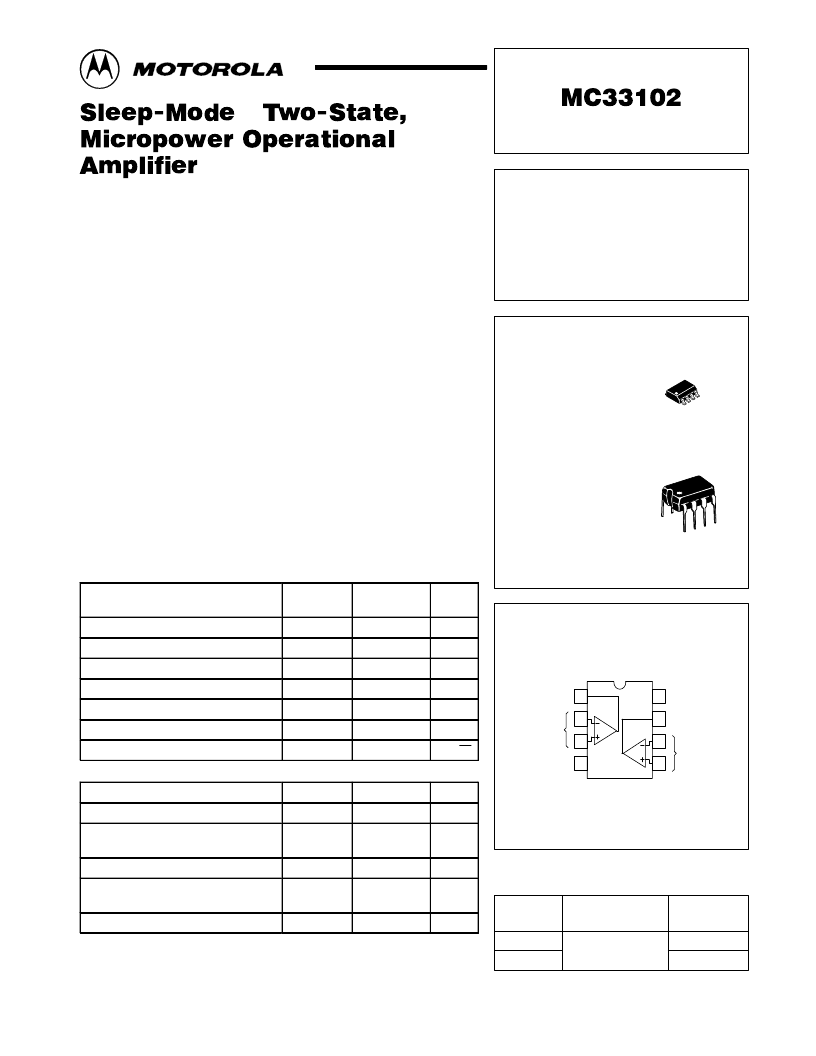- 您現(xiàn)在的位置:買賣IC網(wǎng) > PDF目錄371022 > MC33102P (MOTOROLA INC) DUAL SLEEP-MODE OPERATIONAL AMPLIFIER PDF資料下載
參數(shù)資料
| 型號(hào): | MC33102P |
| 廠商: | MOTOROLA INC |
| 元件分類: | 運(yùn)動(dòng)控制電子 |
| 英文描述: | DUAL SLEEP-MODE OPERATIONAL AMPLIFIER |
| 中文描述: | DUAL OP-AMP, 3000 uV OFFSET-MAX, 4.6 MHz BAND WIDTH, PDIP8 |
| 封裝: | PLASTIC, DIP-8 |
| 文件頁數(shù): | 1/14頁 |
| 文件大小: | 300K |
| 代理商: | MC33102P |

Device
Operating
Temperature Range
Package
SEMICONDUCTOR
TECHNICAL DATA
DUAL SLEEP–MODE
OPERATIONAL AMPLIFIER
ORDERING INFORMATION
MC33102D
MC33102P
TA = – 40
°
to +85
°
C
SO–8
Plastic DIP
Order this document by MC33102/D
D SUFFIX
PLASTIC PACKAGE
CASE 751
(SO–8)
P SUFFIX
PLASTIC PACKAGE
CASE 626
8
1
1
Output 1
VCC
Output 2
PIN CONNECTIONS
(Dual, Top View)
8
1
Inputs 1
VEE
Inputs
2
2
3
4
1
2
5
6
7
8
1
MOTOROLA ANALOG IC DEVICE DATA
The MC33102 dual operational amplifier is an innovative design concept
employing Sleep–Mode technology. Sleep–Mode amplifiers have two
separate states, a sleepmode and an awakemode. In sleepmode, the
amplifier is active and waiting for an input signal. When a signal is applied
causing the amplifier to source or sink 160
μ
A (typically) to the load, it will
automatically switch to the awakemode which offers higher slew rate, gain
bandwidth, and drive capability.
Two States: “Sleepmode” (Micropower) and “Awakemode”
(High Performance)
Switches from Sleepmode to Awakemode in 4.0
μ
s when Output Current
Exceeds the Threshold Current (RL = 600
)
Independent Sleepmode Function for Each Op Amp
Standard Pinouts – No Additional Pins or Components Required
Sleepmode State – Can Be Used in the Low Current Idle State as a
Fully Functional Micropower Amplifier
Automatic Return to Sleepmode when Output Current Drops Below
Threshold
No Deadband/Crossover Distortion; as Low as 1.0 Hz in the Awakemode
Drop–in Replacement for Many Other Dual Op Amps
ESD Clamps on Inputs Increase Reliability without Affecting Device
Operation
Sleep–Mode is a trademark of Motorola, Inc.
TYPICAL SLEEPMODE/AWAKEMODE PERFORMANCE
Characteristic
Sleepmode
(Typical)
Awakemode
(Typical)
Unit
Low Current Drain
45
750
μ
A
Low Input Offset Voltage
0.15
0.15
mV
High Output Current Capability
0.15
50
mA
Low T.C. of Input Offset Voltage
1.0
1.0
μ
V/
°
C
High Gain Bandwidth (@ 20 kHz)
0.33
4.6
MHz
High Slew Rate
0.16
1.7
V/
μ
s
Low Noise (@ 1.0 kHz)
28
9.0
nV/ Hz
MAXIMUM RATINGS
Ratings
Symbol
Value
Unit
Supply Voltage (VCC to VEE)
Input Differential Voltage Range
Input Voltage Range
VS
VIDR
VIR
+36
V
(Note 1)
V
Output Short Circuit Duration (Note 2)
tSC
TJ
Tstg
(Note 2)
sec
Maximum Junction Temperature
Storage Temperature
+150
–65 to +150
°
C
Maximum Power Dissipation
PD
(Note 2)
mW
NOTES:
1.Either or both input voltages should not exceed VCC or VEE.
2.Power dissipation must be considered to ensure maximum junction temperature (TJ)
is not exceeded (refer to Figure 1).
Motorola, Inc. 1996
Rev 0
相關(guān)PDF資料 |
PDF描述 |
|---|---|
| MC33110D | LOW VOLTAGE COMPANDER |
| MC33110 | LOW VOLTAGE COMPANDER |
| MC33110P | ECONOLINE: RSZ/P - 1kVDC |
| MC33111D | LOW VOLTAGE COMPANDER |
| MC33111P | ECONOLINE: RSZ/P - 1kVDC |
相關(guān)代理商/技術(shù)參數(shù) |
參數(shù)描述 |
|---|---|
| MC33110 | 制造商:MOTOROLA 制造商全稱:Motorola, Inc 功能描述:LOW VOLTAGE COMPANDER |
| MC33110D | 制造商:MOTOROLA 制造商全稱:Motorola, Inc 功能描述:LOW VOLTAGE COMPANDER |
| MC33110P | 制造商:MOTOROLA 制造商全稱:Motorola, Inc 功能描述:LOW VOLTAGE COMPANDER |
| MC33111 | 制造商:FREESCALE 制造商全稱:Freescale Semiconductor, Inc 功能描述:Low Voltage Compander |
| MC33111D | 制造商:FREESCALE 制造商全稱:Freescale Semiconductor, Inc 功能描述:Low Voltage Compander |
發(fā)布緊急采購(gòu),3分鐘左右您將得到回復(fù)。